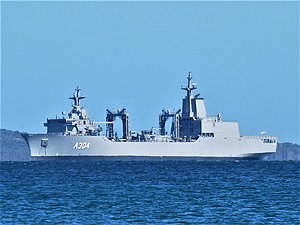 Stalwart in Cockburn Sound, December 2021
| |
| Class overview | |
|---|---|
| Name | Supply class |
| Builders | Navantia, Ferrol |
| Operators | |
| Preceded by | HMAS Sirius, HMAS Success |
| Cost | |
| Built | 2018–present |
| Planned | 2 |
| Completed | 2 |
| Active | 2 |
| General characteristics | |
| Type | Replenishment oiler |
| Displacement | 19,500 tonnes |
| Length | 173.9 m (570 ft 6 in) |
| Beam | 23.0 m (75 ft 6 in) |
| Draught | 8.0 m (26 ft 3 in) |
| Propulsion |
|
| Speed | 20 knots (37 km/h; 23 mph) |
| Range | 6,000 nmi (11,000 km; 6,900 mi) at 13 knots (24 km/h; 15 mph) |
| Complement | 122 |
| Armament |
|
| Aircraft carried | 1 helicopter |
The Supply class is a class of replenishment oilers of the Royal Australian Navy, a role that combines the missions of a tanker and stores supply ship. As such they are designated auxiliary oiler replenisher (AOR). They are tasked with providing ammunition, fuel, food and other supplies to Royal Australian Navy vessels around the world. There are two ships in the class, Supply and Stalwart.[2] The project is expected to cost anywhere between $1 and $2 billion. Navantia were selected to build a design based on the Spanish Navy's current replenishment vessel Cantabria, which entered service in 2011.[3]
- ^ Attopardi, Mario (June 2020). "New AORs miss chance to fit next-gen self-defence". Defence Technology Review. No. 68. p. 38. Retrieved 2 May 2021.
- ^ Dominguez, Gabriel (17 November 2017). "Australia names future replenishment vessels". IHS Jane's 360. Archived from the original on 18 November 2017. Retrieved 19 November 2017.
- ^ "Australia selects Navantia for new replenishment ship". IHS Jane's 360. Archived from the original on 13 March 2016. Retrieved 14 March 2016.
